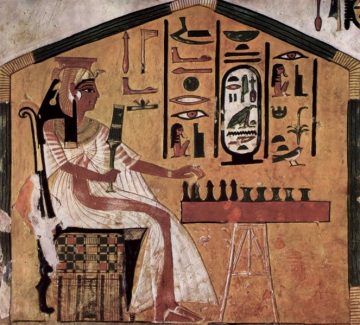Alex Andriesse in The Public Domain Review:
 Ten thousand years ago, in the Neolithic period, before human beings began making pottery, we were playing games on flat stone boards drilled with two or more rows of holes.1 By the Early Dynastic Period in Ancient Egypt, three millennia later, board games were already represented in hieroglyphs. And on the wall of Nefertari’s tomb, built in the twelfth or thirteenth century BCE, someone painted the queen playing Senet, one of three Ancient Egyptian board games whose pieces have come down to us, along with Mehen and Hounds and Jackals.
Ten thousand years ago, in the Neolithic period, before human beings began making pottery, we were playing games on flat stone boards drilled with two or more rows of holes.1 By the Early Dynastic Period in Ancient Egypt, three millennia later, board games were already represented in hieroglyphs. And on the wall of Nefertari’s tomb, built in the twelfth or thirteenth century BCE, someone painted the queen playing Senet, one of three Ancient Egyptian board games whose pieces have come down to us, along with Mehen and Hounds and Jackals.
The ancient Greeks, for their part, had Tabula, an ancestor of backgammon; the Romans added Latrones, an ancestor of chess. All across the ancient Near East, people played the Game of Twenty Squares, while in ancient China they played Liubo and in ancient India Moksha Patam, which was rechristened Snakes and Ladders when colonials imported it to Britain in the Victorian era. Wherever there has been civilization, strange to say, there have been games played on boards.
Until about the seventeenth century, these games tended to be traditional folk inventions that could not be traced back to a maker. Their boards were also relatively abstract, consisting of squares, triangles, spirals, or holes.2 With the advent of the Enlightenment and the rise of capitalism, however, the board games of Europe — like so much else on the continent — began to change.
More here.
